The art of a Salesforce implementation can differ immensely from any other platform project your organization may have undertaken in the past, thanks to the comprehensive nature of Salesforce’s solutions. Once onboard, Salesforce becomes a single source of truth for your organization and its personnel. However, none of this is possible without proper change and process management.
Here is a list of 10 steps to make sure your Salesforce implementation journey is a success.
01 UNDERSTAND BUSINESS DRIVERS
Business drivers are a key criterion that either build and/or protect the value of the business. To identify the drivers on which to focus, the business should address specific questions, for example: Which factors will have most significant impact on the value of the business?
Altify’s Customer Revenue Optimization benchmark study found that companies project that 58% of their growth in the next 12-18 months will come from existing customers.
02 ENGAGE STAKEHOLDERS
Stakeholder management focuses on building relationships; by engaging individuals via consultation, communication, negotiation, etc., you are able to get a clear understanding of business needs and priorities. It is also important because it helps to enable successful project delivery.
One way to ensure correct stakeholder management is to ensure that stakeholders are mapped according to their roles and relevance to what you are trying to achieve. According to McKinsey, “A typical organization can expect that 50% of the value in their plans is addressed by 15-20 roles.” There is, as a result, a “sweet spot” to focus on the input of 20-30 people who can address nearly 75% of value.
03 SET OBJECTIVES
To support business drivers, it is important to set objectives signed off by your business stakeholders. Ensure goals meet criteria such as SMART parameters; they should be specific, measurable, actionable, relevant, and time-bound. The SMART approach changes the way we set and measure goals through its framework; it eliminates generalities and guesswork, setting clear timelines and making it easier to manage risk.
According to Hubspot, “52% of businesses believe that SMART goals help them achieve their goals more often than if they didn’t use a SMART framework.”
04 ESTABLISH TIMESCALES
In order to meet your objectives and goals, it helps to have a full overview of the time needed to achieve all the activities, plan the work, and have the tasks on track to avoid missing deadlines.
One common mistake is to neglect to ensure planning and project stand-up time is wrapped into timescales. The best project phase to establish timescales is during your discovery; there should be a firm understanding of time constraints and considerations before going into the design phase.
05 UNDERSTAND YOUR DATA
Data underpins every capability that your teams will use; as such, setting out a data model and processes for data capture/reporting provide an effective tool for setting data objectives. Likewise, examining the data provided and understanding its use helps to ensure that data is concise (no duplicates), complete (no missing data values), and in a consistent format (e.g., all file data starts with GB_File1_Example).
A McKinsey Global Institute survey found that data-driven organizations are 23x more likely to acquire customers, 6x as likely to retain customers, and 19x more likely to be profitable.
06 CHOOSE THE RIGHT PRODUCT
To select the best product, it is important to focus on the priorities and needs of the client. There may be several products that, in conjunction, fit your business requirements or one product that fits all of your needs.
For example, if a company wants to increase the customer retention rate, they are likely to benefit from using an appropriate tool such as SFMC Journey Builder. With Journey Builder, you can plan your data and content needs and create an outline before you create the journey. With this tool, just increasing customer retention by 5% could lead to an increase in profit of 25-95%.
07 PRIORITIZE YOUR WORKLOAD
Prioritizing your workload helps decide what order tasks should be completed based on their importance. This helps to complete urgent tasks first, meet deadlines, and allocate more time to finish larger tasks. We often recommend addressing larger tasks early in your project to ensure that consideration can be made should there be increased complexity due to task size; this is called front-loading.
08 HIGHLIGHT RISKS AND DEPENDENCIES
Risk encapsulates anything that presents a challenge to the delivery of your project objectives. Risks should be mitigated and identified as early as possible to avoid impacting your progress. A certain level of risk tolerance should also be agreed upon at the project conception to ensure success.
Project teams should all hold the responsibility to ensure that risks are not only raised but mitigated at every relevant step; failure to manage things like risks and issues creates conflicts in the later phases of the project.
09 ONBOARD STAFF
The onboarding process can take time, but it is important as it brings long-term results. Alongside training, there are a number of capabilities that support team onboarding including Trailhead, videos, documents, and other strategies.
Sales teams with efficient onboarding processes experience 10% greater sales growth rates and 14% better sales goal attainment.
10 CELEBRATE PROGRESS
It is important to acknowledge and celebrate progress. Appreciating the work you’ve done can improve your morale and keep you motivated to keep going. Celebrating progress ensures that personnel are also brought into the finalization of the process: 63% of people who are recognized at work report themselves as unlikely to seek a new job in the next 3-6 months.
Do not forget to follow up by measuring usage and adoption. There are several free tools like the Salesforce Adoption Dashboards which can help!
Looking to implement your first or next Salesforce cloud? Talk to us and understand what an experienced partner with 18+ years of expertise can do for your journey towards Salesforce success. Learn more about our Salesforce practice and reach out to our experts right here.







